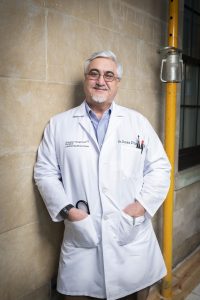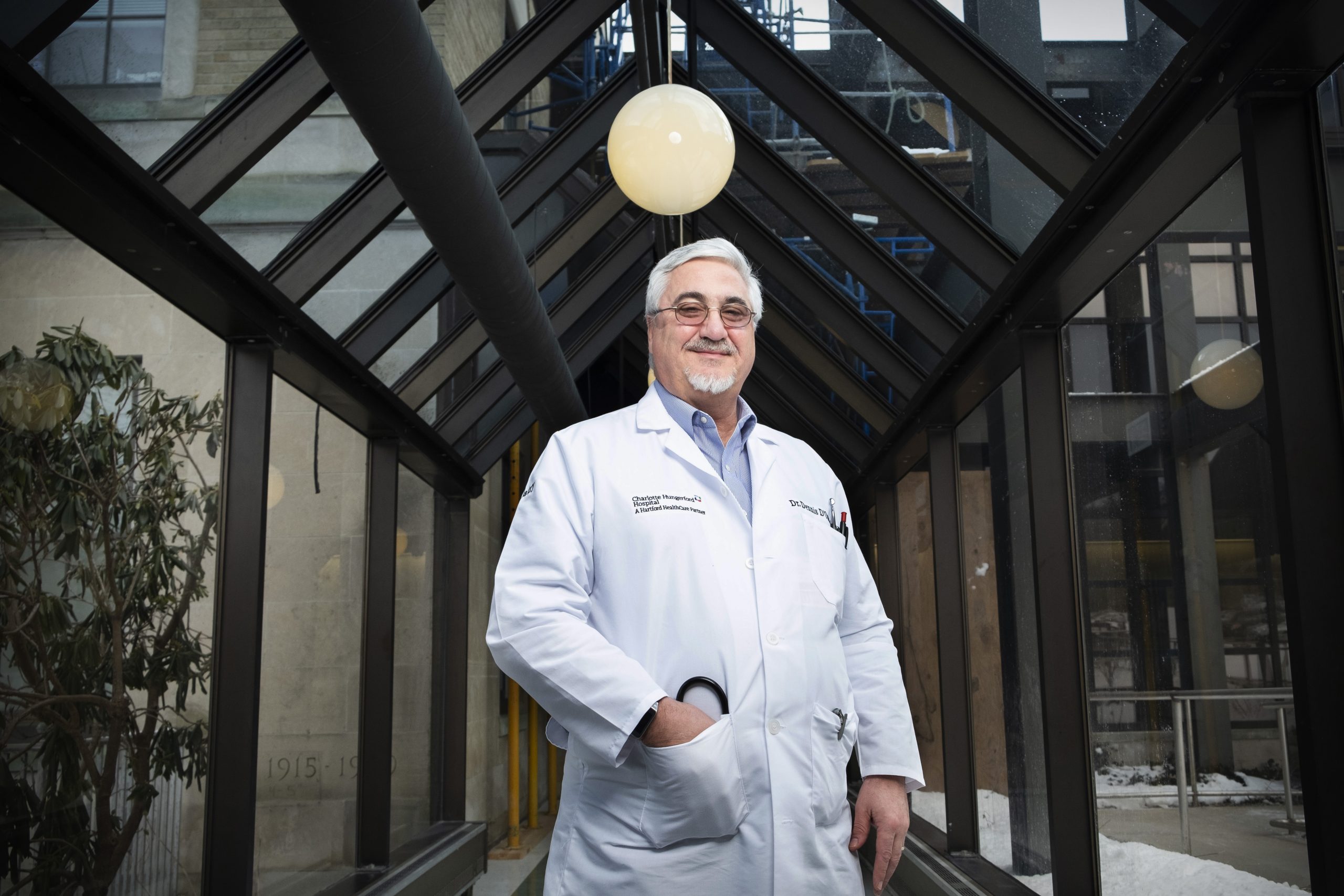Dennis D’Onofrio, DPM, medical director of the Charlotte Hungerford Hospital Foot Center, first entered the podiatric field during the running boom of the late 1970s, when demand for foot specialists was on the rise.
In college, D’Onofrio minored in biology and chemistry but was not technically a pre-med student. Although he was interested in medicine, he was initially unsure of what he wanted to do after graduation.
“One of my professors saw that I was good with my hands, and knew I was an athlete and a big fan of sports,” Dr. D’Onofrio recalls. “He said, ‘Why don’t you look into podiatry?’ ”
D’Onofrio took a year off to ski – and to consider this specialty – and started podiatry school the following year. After graduating from what is now the Temple University School of Podiatric Medicine, he did a year-long preceptorship with the Yale Podiatry Group, followed by a two-year residency at the VA Medical Center in West Haven in reconstructive foot surgery.
While a resident, Dr. D’Onofrio often visited a friend who summered in Goshen, and he also moonlighted with a podiatrist in Waterbury, the only one in the region at the time. “I liked what I saw in this area, so I hung a shingle in Torrington, saw 11 patients my first week, and never looked back,” he says. “I love my profession.”
Pursuing his passion
A Connecticut native, Dr. D’Onofrio was born in Hamden, attended prep school at Westminster School in Simsbury, and spent one year at UConn before transferring to St. Lawrence University in Canton, N.Y. He first learned of CHH on one of his trips to Goshen. He joined the staff in 1990 and has served as chief of podiatric surgery for most of his tenure at the hospital.
Dr. D’Onofrio developed a strong interest – and expertise – in diabetic limb salvage during his residency, and treating the “diabetic foot” has been a large part of his practice. In 2017, CHH opened its Diabetic Foot Center, allowing Dr. D’Onofrio to further pursue this passion. Last summer, the CHH Diabetic Foot Center expanded its scope and incorporated the private practice that Dr. D’Onofrio shares with Dr. Benish Ali. Now known as the CHH Foot Center, it offers a full range of podiatric services, including diabetic foot care.
According to Dr. D’Onofrio, diabetics face increased risk for podiatric problems for several reasons. “Diabetes affects feet in three ways,” he explains. “It affects the blood flow to the foot, it dulls the sensation and perception of touch and pain, and it impairs the body’s ability to fight infection.” Because of these issues, seemingly minor foot problems, like calluses, bunions, or ingrown toenails, can be limb threatening, he says.
“A patient can develop a hardened callus over their bunion which can turn into an ulcer, for example,” he says. “If you are putting weight on a prominent area of the foot, the skin builds up to protect itself and you don’t know when to stop walking on it because you don’t have the protective mechanism of pain. You can literally bore a hole into your foot, get infected, and not feel it.” Indeed, Dr. D’Onofrio says he has had patients come in with nails sticking up through their shoes and into their feet.
Limb salvage
Because diabetics have impaired blood flow and a compromised ability to fight infection (in part because white blood cells crucial to the immune response may not be able to reach the infection site), their body’s capacity to heal wounds that develop on their feet is weakened. “If you have a wound in a dirty place, it gets infected, and that infection can travel to the bone,” says Dr. D’Onofrio, who is also a certified wound care specialist. Controlling that infection could require surgery – even amputation. That’s where limb salvage comes in.
“Limb preservation is my passion,” says Dr. D’Onofrio. “Any foot wound in a diabetic is limb threatening because a) an infection can spread and b) the wound can’t heal properly.” According to Dr. D’Onofrio, it’s very common for surgeons to just remove the infected parts of the limb – or amputate. “But we approach the wound in a multi-disciplinary way, and as a team, we are trying to save limbs.”
What this means is that he and Dr. Ali work alongside vascular surgeons who help to improve blood flow to the feet with stents or balloons; the infectious disease doctor, who helps to identify and control the infection; and the endocrinologist or primary care physician, who make sure a patient’s blood sugar is regulated (out-of-control blood sugar affects wound healing and the ability to battle infection). When necessary, Dr. D’Onofrio removes infected tissue surgically, and can repair tissue defects with procedures like flaps and skin grafts to save or create a functional limb.
Exciting advances in wound care are a particular boon to limb preservation, Dr. D’Onofrio says. Cellular tissue products harvested from amniotic membrane and umbilical cord tissue contain growth factors that enhance and accelerate wound healing, even stubborn wounds that have stalled somewhere along the healing process. Still, 15 percent of people with diabetes develop foot ulcers, and between 14 and 24 percent of those with foot ulcers will require amputation, according to the American Podiatric Medical Association. So Dr. D’Onofrio stresses that preventive foot care is of the utmost importance for those afflicted with diabetes.

A diversity of cases
Though Dr. D’Onofrio sees a lot of diabetic foot wounds, he also treats general podiatric problems like sprains, strains and fractures, performs a fair amount of reconstructive surgery to correct foot deformities like bunions and hammertoes, and provides routine callus care. “That’s the beauty of what being a podiatrist is – there’s a lot of diversity,” he says. “In one room can be this huge diabetic foot wound, the next patient could be a post-op bunion, the next could be a fracture, and the next could have Athlete’s Foot.”
Unfortunately, Dr. D’Onofrio notes, many people in need of podiatric care don’t seek it. “People tend to think that foot pain is something you have to live with – that’s just not the case,” he says. “If your feet are painful, there is something that can be done about it.”
For example, Dr. D’Onofrio says he often sees patients with heel pain who tried to self diagnosis and self treat, and that they ended up spending long periods of time in discomfort before seeking help. “Heel pain is commonly from plantar fasciitis, an inflammation of the ligament that attaches to the heel,” he says. It’s caused by the foot flattening out excessively, causing the ligament to become strained and inflamed.
“Pronation” is the natural side-to-side movement of the foot as a person walks or runs. When someone “overpronates,” the ankle rolls too far downward and inward with every step, placing excessive weight on the inside of the foot. Overpronation is most common in people with flat feet.
Anyone who overpronates is susceptible to plantar fasciitis, not to mention other problems like bunions and hammertoes. “Overpronation is the root of all evil,” Dr. D’Onofrio says. “You can try to control it with orthotics. It’s not going to correct any problems, but it can slow down the progression of these conditions.”
Ultimately, surgery is the only way to correct deformities like bunions and hammertoe. Though Dr. D’Onofrio does not advocate surgery unless a bunion is painful, he says that the sooner you fix such deformities, the better the results.
“It’s like when your car alignment is off and your tires wear unevenly – if your great toe joint is out of alignment, the joint begins to wear,” he says. “We do more bunion and hammertoe [surgery] than any other procedures.”
Ensuring that feet last a lifetime
One thing that is gratifying about podiatry, says Dr. D’Onofrio, is that podiatrists can offer relief to a patient almost immediately. “Most people who come in with a problem – say, an ingrown toenail, a painful callus or a wart – 80 percent of the time, patients are going to walk out of the office feeling better. That’s very rewarding.” Even those with heel pain can get relief from a cortisone injection, he adds. But first, they need to seek treatment.
“People need to look at their feet as they would any other important part of their bodies. If something doesn’t seem to be right, they need to seek help – just as they would if it was their eyes or ears or hands or heart,” says Dr. D’Onofrio. “People shouldn’t take their feet for granted – they need to last a lifetime.”
Lori Miller Kase is a freelance writer living in Simsbury.
Connecticut Headshots, located in Avon, offers corporate portrait photography services to professionals in a variety of industries. Visit connecticutheadshots.com








More Stories
Jamie Shawver, D.O.: The Modern-Day Family Doctor
Leading in Urologic Oncology: Ryan Dorin, M.D., Works on Expanding Patient Care
UConn Health Stands at the Forefront of Comprehensive Sickle Cell Treatment in the U.S.